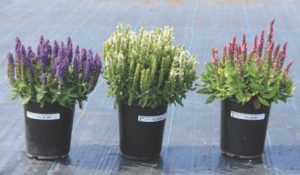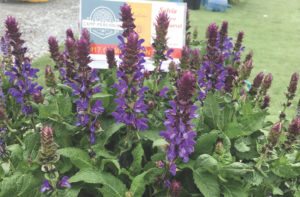
Comparing Salvia nemorosa and Leucanthemum
In 2016, Pacific Plug & Liner increased its focus and investments in the hardy perennial market by dropping our annual listings and increasing our perennial offerings. Trials are an important part of our focus, not only for our own growing experience but to learn more about the products we offer so we can provide better growing information to our customers.
During our biggest trialing season, Pacific Plug & Liner holds a comparison trial of one genus, showcasing the trial at the California Spring Trials but also evaluating the trial before and after the event as we try to pick a genus of plant that can bloom near that time but never force them for the show. This year we decided to tackle two genera since the numbers of varieties in each was not a long list, both leucanthemum and Salvia nemorosa. Weeks 41 to 43 were targeted as the plant date for the trial to have enough time to bulk before winter conditions set in. Being in Watsonville, California, we can get away with this later fall planting date more than northern areas of the country.
For a summarized list on plant dates, varieties and flowering times, go to: www.dropbox.com/s/7t3gi2vgtvykzif/2017ComparisonTrialSummary.pdf
For a detailed summary of the trials, including photos, go to: www.dropbox.com/s/rgpxk1402kauhgd/2017TrialResults.pdf
Trial Conditions
All crops were planted into 2.5-quart sized pots using a 128-cell liner. The soil was comprised of peat, perlite and bark, mixed with a slow-release fertilizer. All crops were grown outdoors in Watsonville on the ground, in traditional perennial growing fields with overhead irrigation and zero supplemental lights or heat.
Watsonville is known for its mild coastal climate, with day temperatures usually in the mid 60s to low 70s and night temperatures in the low to mid 50s. In October 2016, at time of planting, we did have a few warm days with temperatures getting up to 90° F, but our night temperature still ranged from upper 40s to upper 50s. By November, it started to cool off a bit with day temperatures in the mid 50s and near the end of the month we had had our first freezing night temperatures. These trends continued January through February. Then, we started to warm up a little for spring, which got us back to our average.
In 2016, the rain returned to California, making the winter season a lot wetter than it has been in years. Luckily all of the plants were well established before the rainy season so all of the extra moisture had little impact on overall health. At
the time of Spring Trials (week 15 of 2017), we were just below 13 hours of day length.
Leucanthemum

For leucanthemum, our goal was to trial compact varieties that have been marketed for a 2.5-quart to 1-gallon program. We were also hoping to find varieties that bloom in time for early spring sales. Leucanthemum typically blooms late spring to early summer and generally needs, or benefits from, vernalization for best bloom power. That being said, breeders are furiously working on improved versions that need little to no vernalization.
One of the issues I have seen with fall-planted leucanthemum is that by the time they start to bloom in May or June they have really outgrown the pot, making them hard to keep watered and hard to ship. With so many new varieties coming out on the market claiming compactness and earlier blooming we were hopeful to find a solution to this common problem. One well-known variety, ‘Darling Daisy’ (Green Fuse Botanicals), is day-neutral so it is generally the earliest to flower for most growers. The issue with this variety can be filling the pot since it just wants to start blooming immediately upon planting. ‘Darling Daisy’ was in the trial and was the first to bloom, well before any other variety. First buds were already showing in week 5, by week 9 first flowers were showing, and by the Spring Trials event in week 15 they were in full flower.
The only other variety trialed that even came close to ‘Darling Daisy’ was also from Green Fuse called ‘Angel Daisy’. This variety was fully budded with a few open flowers by week 15 and by week 17 in full flower. ‘Angel Daisy’ is still a compact variety, but it is larger than ‘Darling Daisy’. The rest of the varieties trialed all bloomed later, around weeks 19 and 20. I know breeders are still working on earlier flowering leucanthemum and, by no means, did we trial everything available so we will definitely be running this trial again to capture any missed varieties and new varieties.
One of my favorite varieties trialed this year was ‘Western Star Leo’ (Syngenta Flowers). Although not early blooming, it impressed me with a very uniform and dense habit, along with pure white, perfectly rounded flowers.

Salvia
When I mentioned we were trialing Salvia nemorosa I had a few comments that it was a boring category. My comment back was, “If it is so boring why are there so many?” A major reason to trial this category was to see the differences as it seems every breeder has their own version, so we trialed all of the varieties we could get our hands on. We also included hybrids that are close to nemorosa, including x superba and x sylvestris. For this trial we compared varieties both from cutting and seed.
Most varieties do not need vernalization to bloom but will benefit from it with a fuller habit and more flowers. With our mild climate we observed a few varieties blooming in the fall shortly after planting, including the Salute series and ‘Spring King’ (both Dümmen Orange), so these definitely win earliest to bloom. Because of this we needed to trim them back for overwintering. Even after this trim ‘Spring King’ still bloomed before any other variety in the spring.
Despite my original thought that many varieties would look the same, the trial pointed out several differences in varieties. For one, there are three different sizes available to growers: large, medium and compact. While some are easy to predict size due to the name, i.e., Sensation series, others are not. Growers should do some research before moving to new varieties to be sure they are not surprised by the habit. All final measurements can be found at the first link mentioned on page 28.

Speaking of habits, we made an interesting observation that most compact varieties seemed to come on a bit later than the medium and large varieties. This included the Sensation Compact series (Florensis) and Marcus (Rijnbeek and Son). Seeded varieties, New Dimension Blue and Rose (PanAmerican Seed), also bloomed a little later than many vegetative varieties and had a more compact habit.
Looking at the series trialed, our observation was there was really no series that exactly lined up in bloom time. The good news is many were very close, including the Lyrical (Darwin Perennials), New Dimension and Salute (Dümmen Orange) series so that earlier blooming colors could be held back if all colors needed to ship at the same time.
With so many varieties it is always hard to pick a “best of show” but there were a few notables. Best white was ‘Snow Hill’ due to the extremely full habit, high bloom count and uniformity. Best pink was ‘Bordeau Rose’ (Syngenta Flowers). This one was really impressive with its dark stems and rich deep rose flowers giving such a nice contrast along with a tidy and upright habit. Best blue or purple was a toss-up. With super large flowers ‘Blue Marvel’ (Darwin Perennials) was uniquely different from most other varieties trialed, the oversized flowers making it a real standout. Another nice blue, an oldie but goodie, ‘May Night’ produces large spikes in abundance. Also affectionately called “May Nightmare” because of the difficulty in producing URCs but when it is so beautiful, I can see why so many still want it.

Final Thoughts
That wraps up our 2017 Comparison Trial. Join us at the 2018 California Spring Trials to check out the lavender and dianthus trials we will have on display. Be sure to save plenty of time for viewing … because there are a lot of varieties in those two categories!
Our Perennial Passion at PP&L brings you grower solutions with the support you need for best success along with exclusive ground-breaking varieties. Trials like this provide us valuable information that we can pass along to our customers and help us to focus our offerings that we provide to the marketplace. For availability on any of the above mentioned varieties, please be sure to check our Liner-Bility tool that features 72 weeks of forecasted availability, located here: www.ppandl.net/avail-info/ppl%20availability.xlsm


 Video Library
Video Library 




















